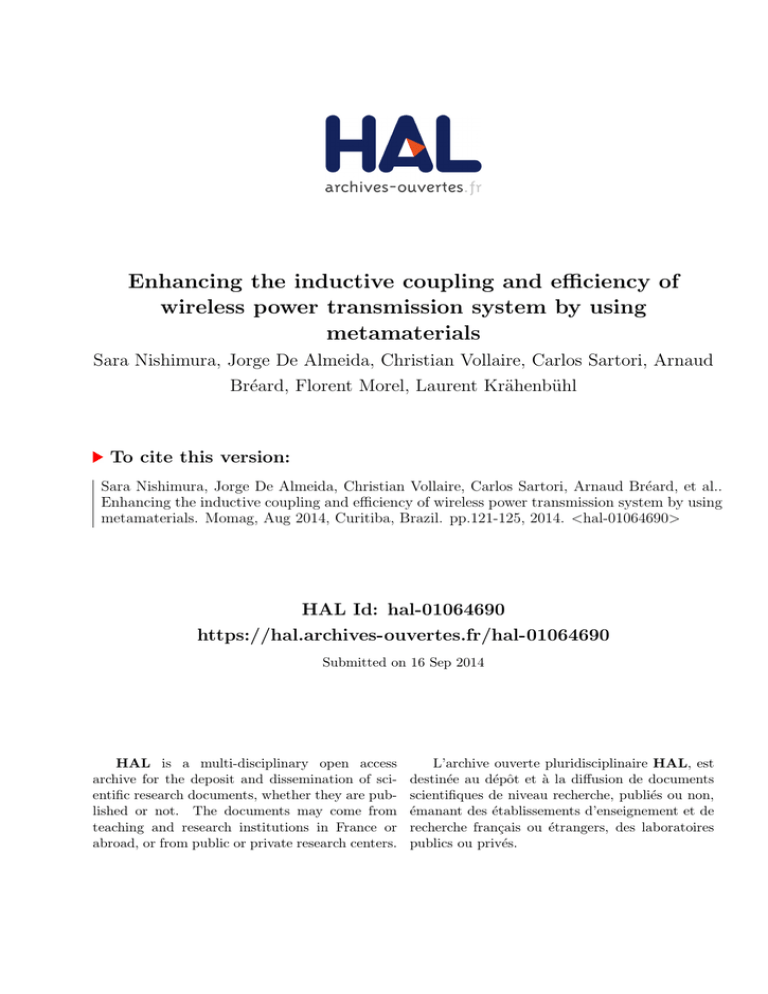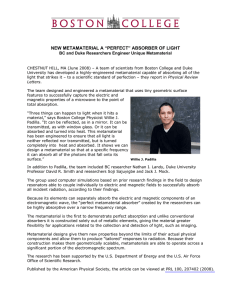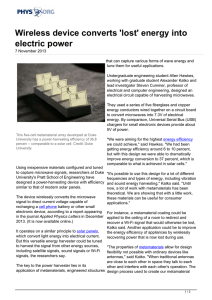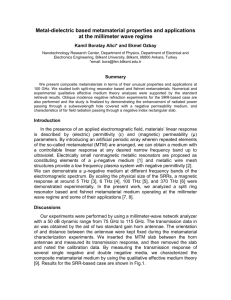Enhancing the inductive coupling and efficiency of wireless
advertisement

Enhancing the inductive coupling and efficiency of wireless power transmission system by using metamaterials Sara Nishimura, Jorge De Almeida, Christian Vollaire, Carlos Sartori, Arnaud Bréard, Florent Morel, Laurent Krähenbühl To cite this version: Sara Nishimura, Jorge De Almeida, Christian Vollaire, Carlos Sartori, Arnaud Bréard, et al.. Enhancing the inductive coupling and efficiency of wireless power transmission system by using metamaterials. Momag, Aug 2014, Curitiba, Brazil. pp.121-125, 2014. <hal-01064690> HAL Id: hal-01064690 https://hal.archives-ouvertes.fr/hal-01064690 Submitted on 16 Sep 2014 HAL is a multi-disciplinary open access archive for the deposit and dissemination of scientific research documents, whether they are published or not. The documents may come from teaching and research institutions in France or abroad, or from public or private research centers. L’archive ouverte pluridisciplinaire HAL, est destinée au dépôt et à la diffusion de documents scientifiques de niveau recherche, publiés ou non, émanant des établissements d’enseignement et de recherche français ou étrangers, des laboratoires publics ou privés. MOMAG 2014: 16º SBMO - Simpósio Brasileiro de Micro-ondas e Optoeletrônica e 11º CBMag - Congresso Brasileiro de Eletromagnetismo Enhancing the inductive coupling and efficiency of wireless power transmission system by using metamaterials Sara Izumi Nishimura1,2, Jorge Virgilio de Almeida1,4, Christian Vollaire1, Carlos A. F. Sartori2,3, Arnaud Breard1, Florent Morel1, Laurent Krähenbühl1 1 Université de Lyon – Ampère (CNRS UMR5005, ECL), 69134 Écully, France 2 Escola Politécnica – Universidade de São Paulo PEA/EPUSP - São Paulo-SP, Brazil 3 Instituto de Pesquisas Energéticas e Nucleares IPEN/CNEN-SP - São Paulo-SP, Brazil 4 Pontifícia Universidade Católica do Rio de Janeiro PUC-Rio - Rio de Janeiro-RJ, Brazil Thus, a metamaterial arrangement suitable for the frequency range of interest and suitable for inductive WPT is proposed. Analytical calculations and numerical simulations of the properties of the proposed metamaterial and its impact on power transfer efficiency are presented and supported by experimental measurements. The related results are shown and discussed. Abstract— Over recent years, the interest in using inductive wireless power transmission for many applications has grown. One of the major limitations of this technology is the limited operating distance. Some recent works have suggested using synthesized materials known as metamaterials to improve the power transfer efficiency over distance. Due to their unique electromagnetic properties such as negative permeability, metamaterials can be used to enhance the evanescent waves of the near-field. In the present work, the usage of a magnetic metamaterial to increase the inductive coupling by means of enhanced evanescent waves is studied. Analytical calculations and numerical simulations of the proposed metamaterial and its impact on power transfer efficiency are presented and supported by experimental measurements. II. A. Historical evolution of the wireless power transmission A crucial point in the history of wireless power transmission took place in 1893 when Nikola Tesla demonstrated that a lamp could be lit remotely without the aid of any conductor. In following years, Tesla devoted much of his time to study telecommunications and wireless power transmission over long distances using earth’s electromagnetic field [8]. Keywords— metamaterials, wireless energy transmission, magnetic coupling, negative permeability. I. WIRELESS POWER TRANSMISSION INTRODUCTION Recently, studies on WPT field regained attention since MIT’s researchers demonstrated in 2007 that efficient nonradiative mid-range WPT was possible. By using strongly coupled loops, they were able to power a 60W light bulb that was 2 meters away from the source, at approximately 45% efficiency [9]. Wireless power transmission (WPT) by magnetic induction is becoming a reliable technology to power devices without the need of the traditional wiring connections. In such a system, power transfer occurs via inductive coupling between conducting loops serving as transmitter and receiver. However, one of the main constraints to the deployment of this technology is the operating distance that is limited by the size of the loops. The efficiency drops dramatically for distances larger than the diameter of the largest loop. So far, many other works based on inductive WPT has been conducted [10]-[13]. Wireless power transfer has been regarded as a practical solution for recharging electric vehicles, smartphones or implantable medical devices [14] [15]. To solve this problem, the usage of metamaterials has been suggested [1]. Such materials may be used as “superlens” over a limited frequency band to enhance the evanescent waves of the magnetic field strengthening the inductive link. B. RLC series circuit The coils used for the power transmission can be modeled as a RLC circuit, as shown in Figure 1. The parameter L is the self-inductance of the coil, R the resistance of the conductor and C the stray capacitance between the loops. Although the model is well known, a brief description of its theoretical concepts is presented: Previous works can be found in the literature related to the application of metamaterials in super high frequency range (GHz and above), i.e., in the references [2]-[7]. The objective of this work is to evaluate the usage of metamaterials as a mean to ameliorate the coupling between the transmitter and receiver loops, and consequently the operating distance of the system, in high frequency range (MHz). The current in the resonance frequency is maximized on the series RLC circuit and it is in phase with the voltage. That is to say, the inductive reactance is equal to the capacitive one 121 MOMAG 2014: 16º SBMO - Simpósio Brasileiro de Micro-ondas e Optoeletrônica e 11º CBMag - Congresso Brasileiro de Eletromagnetismo Moreover, by using a single-negative metamaterial the losses are greatly reduced thanks to a simplified structure. with a 180° phase difference. For frequencies below the resonance frequency , the capacitive reactance predominates over the inductive one. For frequencies higher than , the inductive reactance predominates. Finally, as metamaterials are resonant, they are dispersive in nature [17]. IV. A. Prototype In Figure 2, the prototype arrangement of the metamaterial unit cell is presented. Its geometrical characteristic are dint = 1cm, dext = 2cm, s = 1mm, w = 1mm. The lumped capacitor is a 100pF CMS (1.6mm x 8mm). The cell has two holes to connect the capacitor on its backside. The distance between the centers of each motif is 2.3 cm. The following equation was used to calculate the total inductance of the unit cell [19]: Figure 1- Model RLC of a coil in short circuit [15] Therefore, at the resonance frequency minimum impedance is achieved and the coupling is maximized. C. The quality factor Q An ideal coil has no loss independently of the current flowing through it. In practice, these devices have losses caused by the inherent resistivity of the used conductor. This resistance dissipates energy by Joule effect, which mitigates the quality of the system. • • • • • • The higher this factor is, the closer it approaches to the ideal coil with zero electrical resistance. Thus, the Q-factor is an important design parameter. The efficiency of an inductive system with a weak magnetic coupling can be compensated by a strong Q-factor. The Q-factor of a serie RLC circuit is given by: (2) µ0 = 4π10-7 davg = 0,5(dint + dout) n=4 ρ = ( dint - d out)/ (dint+dout) K1 = 2,34 K2 = 2,75 Where is the number of turns of the square spiral, and and ! are layout coefficients defined in reference [19]. With the proposed dimensions, the calculated inductance is 243 %. Table I compares the theoretical and experimental results for the inductance, the capacitance, the resonance frequency and the Q-factor. (1) III. THE PROPOSED METAMATERIAL ARRANGEMENTS METAMATERIALS A. Definition Metamaterials are engineered structures usually much smaller than the working wavelength whose electromagnetic properties are obtained from its structure rather than its chemical composition [17]. V. EXPERIMENTAL PROTOCOL A. Verification of the metamaterial parameters An impedance analyzer (Agilent Model 4294A 40Hz110MHz) was used to measure impedance of the metamaterial. These results were compared with the theoretical ones and used to verify their accuracy and validity. The working frequency range of the lumped capacitors was also experimentally verified and confirmed to be in the frequency range of interest. It has been shown in reference [4] that conducting periodic structures could be synthesized to achieve negative permeability or negative permittivity at a limited frequency range. Such arrangement of scattering elements can be taken as homogeneous if the unit cell dimensions are much smaller than the guided wavelength and effective constitutive parameters and μ can be attributed to the metamaterial slab [18]. Furthermore, being formed by repeated elements, it is possible to study the properties of the slab just by studying the properties of its unit cell [4]. Negative index media are required to create a “superlens” capable of focusing the near-field. However, for inductive WPT systems, this requirement may be simplified. Considering the quasi-static hypothesis of the near-field, its electric and magnetic components can be considered as independents. So a metamaterial presenting µ < 0 only suffices to achieve a similar effect of focusing of the magnetic field. Figure 2- Unit cell of the prototype 122 MOMAG 2014: 16º SBMO - Simpósio Brasileiro de Micro-ondas e Optoeletrônica e 11º CBMag - Congresso Brasileiro de Eletromagnetismo B. Measurement of the energy received Spiral resonators based metamaterials are supposed to behave as a magnetic superlens that concentrates the evanescent magnetic field around the slab enhancing the inductive coupling, and by consequence, improving the energy transfer. VI. NUMERICAL SIMULATION A. Simulation of the two coils The Method of Moments was applied [20]. The coils were 15cm from each other with the metamaterial placed between them. Three substrates had to be defined. The metamaterial was added after the first configuration with two coils only. Based on the fact that the resonance frequency is 35MHz, a simulation between 5MHz and 50MHz was made. The induced voltage in the secondary circuit has been evaluated with and without the metamaterial slab between the coils. The experiment setup is shown in Figure 3. The transmitter and receiver coils are linked to the Vector Network Analyzer (VNA). The metamaterial is placed between the two coils. B. Results of the simulations Some results concerning the simulations are presented in this item. Figures 6 shows the voltage in the secondary without the metamaterial, and Figure 7, the voltage in the secondary with the metamaterial. Figure 3- Experimental setup C. Experimental results The voltage gain at resonance frequency is defined as: & '( )'* '* (3) Based on the results of Figure 4, G=4. An enhancement of 400% is achieved in the presence of the metamaterial slab. Inductance (nH) Capacitance (pF) Resonance frequency (MHz) Theoretical 246 100 32 Experimental 231 115 35.8 Figure 6- Voltage in the secondary without the metamaterial Q 180 - Table I- Theoretical and experimental parameters of the prototype Figure 7- Voltage in the secondary with the metamaterial According to (3), G = 3.54 for the numerical results. So the experimental and the numerical gain in power transmission in the presence of the metamaterial slab are in an agreement. Although a difference can be realized concerning the voltage at the resonance, both results show a significant increasing of the received energy. It should be mentioned that the measured and analytical resonance frequency were 35,9MHz and 34,5MHz, respectively. These results indicate that additional studies in order to examine the influence of the source variation in the accuracy of the theoretical parameters of the model. Figure 4- Voltage on the secondary with and without the metamaterial. Distance between the two coils: 15cm. 123 MOMAG 2014: 16º SBMO - Simpósio Brasileiro de Micro-ondas e Optoeletrônica e 11º CBMag - Congresso Brasileiro de Eletromagnetismo Acknowledgment Voltage in the resonance frequency Experiment Without the metamaterial 0.0087363 0.0033 With the metamaterial 0.0437234 0.015 Gain 400% Simulation This work was partially supported by BRAFITEC, FUSP and CNPq (307867/2011-00). The authors would like to thank Dr. Thi Quynh Van Hoang and M. Sc. Murilo Hiroaki Seko for their contributions and helpful discussion during the development of this work. 354% Table II- Voltage on the secondary with and without metamaterial on the resonance frequency References [1] VII. CONCLUSIONS The usage of the metamaterial in an inductive coupled system as a mean to improve the magnetic coupling and by doing so increasing the operating distance has been demonstrated. It was considered a frequency range of MHz. Besides the theoretical studies, numerical simulations and experimental measurements were made. During the project other ideas emerged and they will be considered in future works. [2] [3] [4] It should be mentioned that a first prototype was built and have not shown good results since its Q-factor was too low. To improve the Q factor, it was necessary to enhance the inductance by increasing the number of turns of the unit cell and diminish the capacitance of the lumped capacitor. With a four times larger inductance and a 100 times lower capacitance, the resonance frequency has been also increased. The first prototype had a resonance frequency around 3MHz, 100 times smaller than the second one. Despite the increasing of the resonance frequency, the frequency range was still within the range of interest and the Q-factor has achieved an acceptable value (around 180). The analytical values for the inductance, capacitance and resonance frequency calculated for both prototypes were consistent with the values obtained empirically by using the impedance analyzer. [5] [6] [7] [8] [9] Both experimental and numerical results indicate an improvement of the voltage in the secondary around 35MHz, which is in agreement with the expected analytical resonance frequency. They have also a gain around 400%, indicating that the numerical simulation represents with good precision the real system. [10] [11] Concerning future works, the authors can still mention: a) Studies on the the reduction of the operating frequency. It should be stressed that there is a compromise between the frequency and the Q factor which is an obstacle for reducing the working frequency. [12] [13] b) Studies on the visualization of the magnetic field in a cross section that can be a helpful tool to better understand the effect of the metamaterial on the repartition of the magnetic field. [14] c) Additional evaluation of the metamaterial parameter sensibility used in the simulations, as well as the optimization of the position of the metamaterial when placing it close to the secondary and its orientation. [15] [16] d) Study on the system with double resonance to compensate the reactive power of the emitter and the receptor. [17] 124 Lipworth, L., Ensworth, J., Seetharam, K., Huang, D., Lee, J.S., Schmalenberg, P., Nomura, T., Reynolds, M.S., Smith, D.R., and Urzhumov, Y., "Magnetic Metamaterial Superlens for Increased-Range Wireless Power Transfer," Scientific Reports, Jan. 10, 2014 J. Gollub, D. Smith, D. Vier, T. Perram, and J. Mock, “Experimental characterization of magnetic surface plasmons on metamaterials with negative permeability,” Phys. Rev. B, vol. 71, no. 19, May 2005. Filiberto Bilotti, Alessandro Toscano, Kamil Boratay, Ekmel Ozkay, and Lucio Vegni, “Design of miniturized narrowband absorbers based on resonant-magnetic inclusions,” IEEE Trans. Electromagn. Compat., vol. 53, pp. 63–72, Feb. 2011. J.B Pendry, A.J Holden, D.J Robbins, and W.J Stewart, “Magnetism from conductors and enhanced nonlinear phenomena,” IEEE Transactions on microwave theory and techniques, vol. 47, no. 11, pp. 2075–2084, Nov-1999. Bryan J. Justice, Jack J. Mocj, Liheng Guo, Aloyse Degiron, David Schurig, and David R. Smith, “Spatial mapping of the internal and external electromagnetic fields of negative index metamaterials,” Optics Express, vol. 14, pp. 8694–8705, 18-Sep-2006. N. Landy, J. Hunt, and D. Smith, “Homogenization analysis of complementary waveguide metamaterials,” Photon Nanostruct: Fundam Appl, 2013. D.R Smith, Willie J. Padilla, D.C. Vier, S.C. Nemat-Nasser, and S. Schultz, “Composite medium with simultaneously negative permeability and permittivity,” Phys. Rev. Lett., vol. 84, no. 18, 2000. “Wireless power,” http://en.wikipedia.org/wiki/Wireless_energy_transfer. A. Karalis, J. D. Joannopoulos, and M. Soljačić, “Efficient wireless nonradiative mid-range energy transfer,” Ann. Phys., vol. 323, no. 1, pp. 34–48, Jan. 2008. Alanson P. Smaple, David A. Meyer, and Joshua R. Smith, “Analysis, experiment results, and range adaptation of magnetically coupled resonators for wireless power transfer,” IEEE Trans. Ind. Electron., vol. 58, no. 2, pp. 544–554, Feb. 2011. Benjamin L. Cannon, James F. Hogurg, Daniel D. Stancil, and Seth Copen Goldstein, “Magnetic resonant coupling as a potencial means for wireless power transfer to multiple small receivers,” IEEE Trans. Power Electron., vol. 24, no. 7, Jul. 2009. Thuc Phi Duong and Jong-Wook Lee, “Experimental results of highefficiency resonant coupling wireless power transfer using a variable coupling method,” IEEE Microw. Wirel. Compon. Lett., vol. 21, no. 8, pp. 442–444, Aug. 2011. Takehiro Imura and Yoichi Hori, “Maximizing air gap and efficiency of magnetic resonant coupling for wireless power transfer using equivalent circuit and Neumann Formula,” IEEE Trans. Ind. Electron., vol. 58, no. 10, pp. 4746–4752, Oct. 2011. 5th International IEEE Vehicle Power and Propulsion Conference September 7-11, 2009, Dearborn, Michigan, USA. [Piscataway, N.J.]: IEEE, 2009. J. Schuder, J. Gold, and H. Stephenson, “An inductively coupled RF system for the transmission of 1kW of power through the skin,” IEEE Trans. Biomed. Eng., vol. 18, Jul. 1971. Universidad Nacional de colombia, “Circuits elétricos II,” http://www.virtual.unal.edu.co/cursos/ingenieria/2001603/lecciones/cap 5/cap5lec3/cap5lec3.htm. J. B. Pendry, “Controlling Electromagnetic Fields,” Science, vol. 312, no. 5781, pp. 1780–1782, Jun. 2006. MOMAG 2014: 16º SBMO - Simpósio Brasileiro de Micro-ondas e Optoeletrônica e 11º CBMag - Congresso Brasileiro de Eletromagnetismo [20] “ADS- Advanced design system,” http://www.home.agilent.com/pt/pc1297113/advanced-design-system-ads. [18] George V. Eleftheriades, “EM transmission-line metamaterials,” Materials today, pp. 30–41, Mar-2009. [19] S. S. Mohan, M. del M. Hershenson, S. P. Boyd, and T. H. Lee, “Simple accurate expressions for planar spiral inductances,” IEEE Journal of solid-state circuits, Oct-1999. 125



